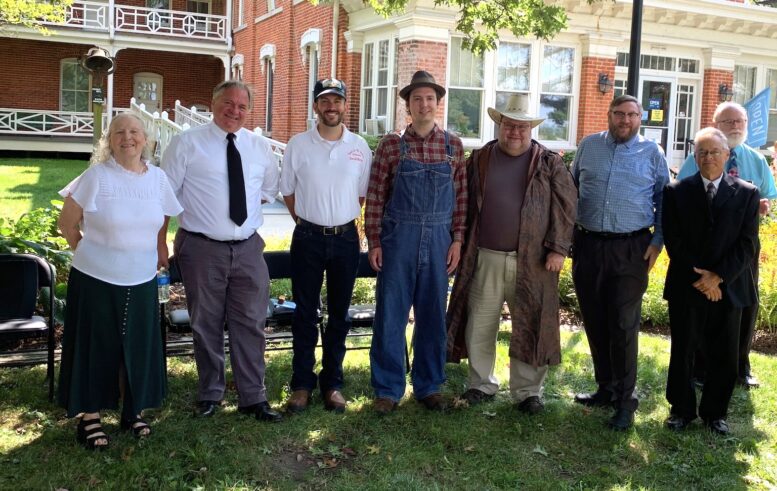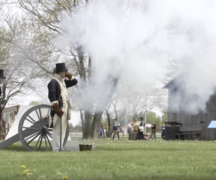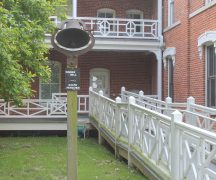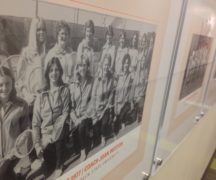By JULIE CARLE
BG Independent News
Collister Haskins, an early settler in northwest Ohio, was one of the signers of the first Wood County Fair constitution in the 1850s. A hundred years later, Darrel Hentges was a 14-year-old boy showing sheep at the fair, unbeknownst to him at the time, on his way to a 63-year record.
They were two of the past Wood County Fair legends who came alive with the help of current county residents during the Wood County Living History Day Sunday afternoon on the grounds of the Wood County Museum. The event, celebrating its own 20th year milestone, commemorated this year’s 150th Wood County Fair by sharing the stories of eight past fair stakeholders.
In addition to Haskins, portrayed by Dale David, and Hentges, presented by his great-nephew Kyle Miller, the first-person stories were shared by Andrew Manville (Rev. Jeff Schooley), James Ordway (Lane Hakel), John Lawrence Clarke (Steve Speck), Claude Frederick “Fred” Haskins (Anderson Lee) and Juliana Lowmaster Hott (Wendy Guion).
A case of strep throat prevented portrayer Rose Drain from sharing the voice of Ethel Keep Berlin, a well-known local artist whose influence on the fine arts department at the fair was visible, according to Living History emcee Keith Guion.
“When she started at the fair there were dozens of photographs flapping around in a tent. By the end of her tenure, there were 600 artists whose work was beautifully displayed,” he said. Her impact lives on today, as evidenced by the hundreds of entries in the fair’s fine arts department. The rest of her story will be told at a later date, Guion said.
For Collister Haskins, a member of the first Wood County Agricultural Society, the fair was about connecting with neighbors who were few and far between in the 1850s. “I was born in 1799 and my family moved to the area in 1817” as pioneers of northwest Ohio’s rugged Black Swamp terrain, he said. His mother, Eunice Pierce Haskins, was a cousin to President Franklin Pierce, and his father
He married Fanny Gunn of Waterville in1918 and eventually homesteaded government-acquired land in Liberty Township. He built a log home along the Portage River, which became the first schoolhouse for 36 children, the site of the first sermon preached in Liberty Township and a stop on the Underground Railroad for enslaved individuals on their journey to freedom, he said.
Known as the “Father of Portage,” his involvement in the community included running a variety store for area residents, petitioning for a post office and then serving as postmaster for 18 years. In addition to his role as an instigator for the Wood County Fair, “I also was seated on the first grand jury of Wood County,” he added. He died in 1872.
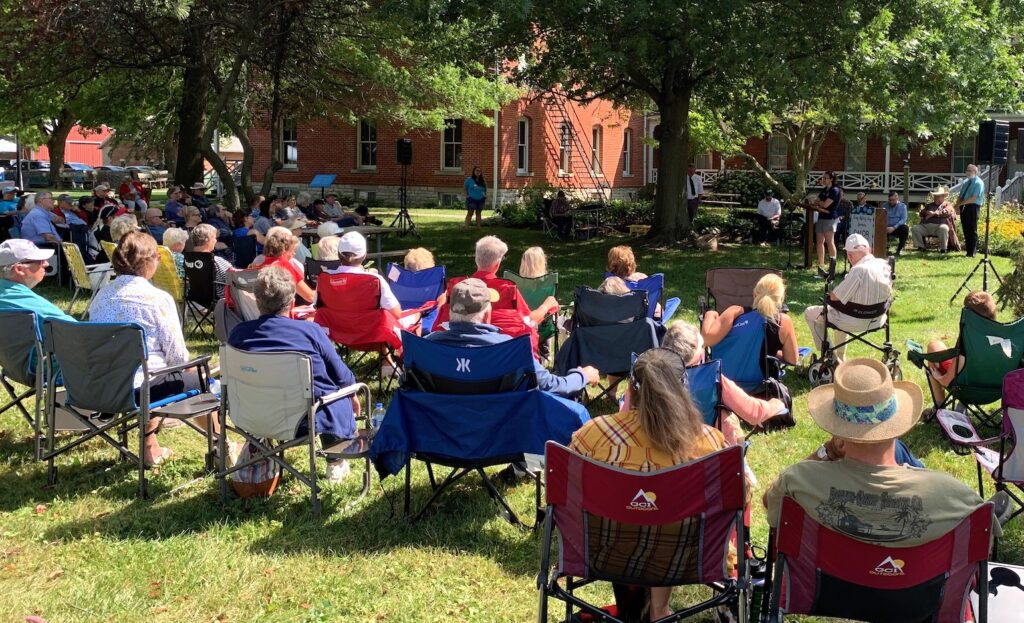
That first Wood County Fair was held on a hill in Bowling Green that is where the Carter House’ now sits at North Church Street and the brick street, Keith Guion said. The fair then moved to Tontogany for several years until a group of Bowling Green residents, including Andrew Manville, decided that Bowling Green, as county seat, should be the rightful location for the county fair.
Manville, who was born in Bowling Green in 1834 to Eli and Elizabeth Manille, was reportedly the second white child born in Plain Township. He farmed for 14 years until his mother urged him to follow in his father’s footsteps and become a doctor. He studied at the medical college in Ann Arbor, Michigan, and earned his medical degree in 1866 from Bellevue Hospital Medical College in New York City.
He also was an entrepreneur, who was involved with the rail industry, as well as housing developments in the area. When the fair was moved to Tontogany for several years, “that didn’t sit well with many of the local businessmen,” he said.
“We created the Wood County Fair Association in 1881 and I was the first president,” adding that they paid $1,500 the first year and $2,500 in two years for the property that is now the BG City Park. “We built a race track, grandstand, building for needlework and fine arts and several livestock barns,” he recalled.
“By 1890, the county couldn’t support two fairs, so we joined forces and BG was the exclusive location for the county fair,” he said.
Manville was killed in a train accident in Custar in 1902.
James Ordway, born in 1842, was another transplant to Wood County. He and his family came to Ohio from Vermont.
He and his brother Tom built many homes in the area including the Chidester Theater and the gallows for Carl Bach, the infamous Wood County murderer who killed his wife Mary in 1881.
He was a longtime director for the Wood County Fair, where he was involved in “everything from chain mechanisms to poultry, but I had a love for horses and racing.”
In 1920 at the age of 78, “I was presented a silver loving cup for 32 years as a director for the fair,” he said.
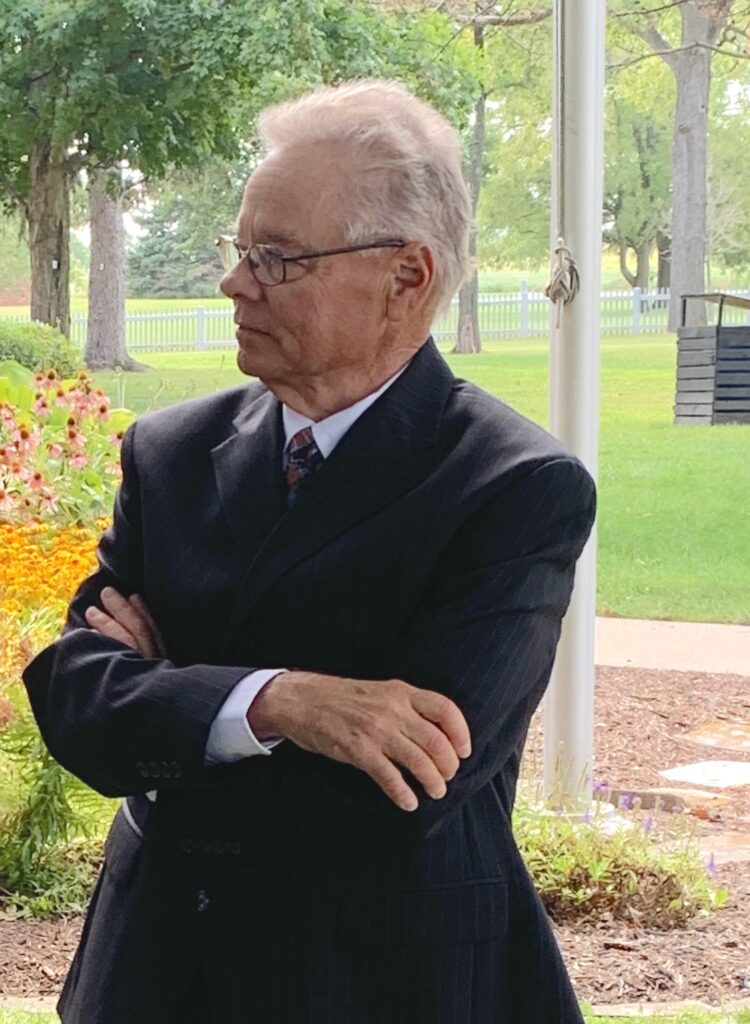
John Lawrence Clarke, born in Bellevue, Ohio, in 1905, was one of the original members of the “new” fair board when it reorganized in 1951. He had been involved in many of the fall festivals and other similar activities before he and a group restarted the fair.
“I remember previous fairs; adversity was something we got used to and got through,” he said. He served as secretary of the fair board until Dean Roach took over, but he remained on the fair board until 1976.
“The year 1951 was a busy year for me. In addition to the fair, I was also the PR chairman for the new Wood County Hospital and was involved with fundraising for equipment for the hospital,” he said. He also belonged to the Bowling Green Kiwanis Club and Trinity United Methodist Church.
He wife Dorothy was an artist, active with the Toledo Artist Club and the Northwest Ohio Watercolor Society. She died in 1986 and he passed away in 1992.
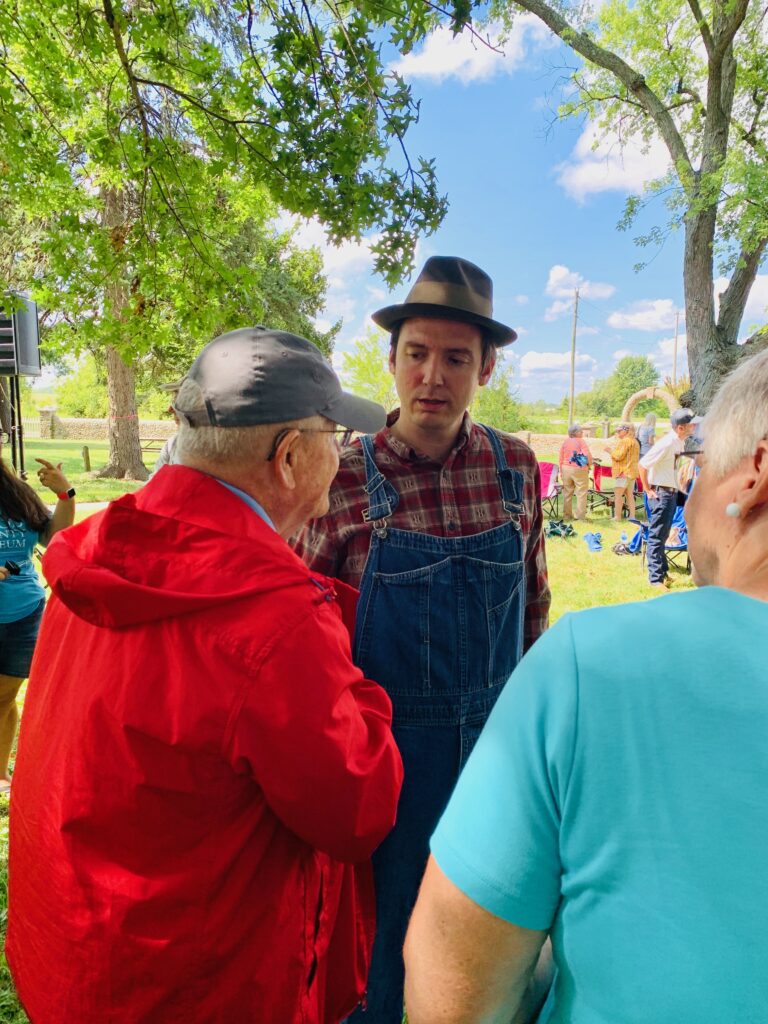
Fred Haskins was a home-grown boy from Plain Township, a farmer, Plain Township trustee and a Wood County Fair Board member for 27 years.
“My passion was horses—draft, ponies and quarter horses—that I passed on to my grandson, Josh Haskins,” he said fondly.
“I was a horse show judge for 24 hours and I put hours and hours of love and work into the fair. In fact, I helped write the first 4-H book for horses and ponies,” he added. He was active in the Ohio Fair Managers Association and earned a state award in 1990 for his involvement in the Wood County Fair.
Former Wood County Fair Secretary Patricia Frost once told him that her boys often named their pets “Fred” after the easy-going, joke-telling fair director and friend.
Juliana Hott “was connected to the fair since before I was born in Bowling Green in 1922,” she said. Her main connection though was through 4-H, which “was important to me for most of my life,” she said.
She was a part of the Friendly Workers sewing, knitting and crocheting 4-H club, the Silver Stars, as well as adviser for BG Spoons and Sew for 15 years (1950-1966) and co-adviser for the Keystone 4-H horse club from 1961-1964.
She and her husband, Paul and two children, Ed and Kathy, lived in one of the oldest Bowling Green houses on Napoleon Road, where they raised horses, chickens and rabbits, including bunnies that a local magician would borrow for his hat tricks, she recalled with a laugh.
Music, horses and 4-H were her passion, but her living was as a florist, including 40 years as owner of The Flower Shop. She was known for beautiful and unique creations, and also used her creativity to provide costumes for the local ice shows.
The “baby” of the bunch, Darrel Hentges, came to the fair board later than the others recognized on Sunday. He didn’t join the board until 1996, but he had been showing sheep—his family’s longtime passion—when he was 14 years old.
“I was involved with the ‘modern’ fair in 1949 when it was the Wood County Harvest Fest,” he said. “I got to show sheep at the Wood County Fair in 1951,” and he continued for 63 years until his death in 2013.
He maintained that goal of showing at the fair even when he was in the Army. He always asked for furloughs that corresponded to the fair, and he was always granted those date. Thoug he rememebered one year that was especially rough when he didn’t arrive in Bowling Green until the night before. “It was a long night getting the sheep ready,” he said.
As a youth, he participated in the “Catch a Calf” contest, which was not an easy task. In his adult years, he “graduated to become the head greaser for the ‘Catch a Pig’ contest,” he said.
He married Ruth Ann Brinker, from another longtime sheep-raising family in Wood County, creating an even broader county sheep dynasty. His father O.C. Hentges and his father-in-law Lawrence Brinker were instrumental in getting the sheep barn built on the Poe Road fairgrounds.
“There were only tents in the early days at the fair, and the fair board built barns for steers and hogs, but not sheep,” Hentges said. Plans for a pole barn for the sheep were discussed but the fair board at that time dismissed the longevity of a pole barn. The families with sheep went ahead and built it and painted it blue. “Today, our barn still stands proudly,” while the beef and hog barns were replaced by the Pratt Pavilion, which Hentges acknowledged was “slicker than snot.”
Though he had the champion sheep in 1951 and 1952, his proudest fair moments were when granddaughter Leesa Corken (now Caris) was crowed Junior Fair Queen in 2008 and when the Darrell Hentges Sportsmanship Award was established in his honor. “I always thought it was important for kids to be good sportsmen even more than receiving blue ribbons and trophies,” he said.
Approximately 15 members of his family were proud to attend Sunday’s event. Daughter Deanne Corken has taken his spot on the fair board to make sure what he started on the fair board doesn’t get forgotten.

